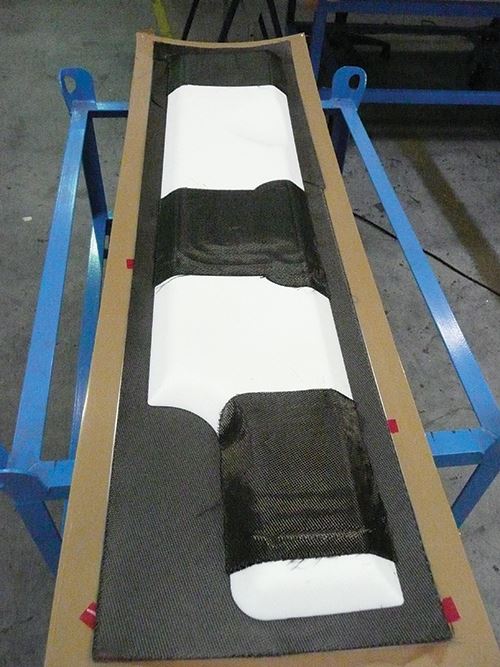PMI foam core outperforms honeycomb in infused nose landing gear doors
The results of Airbus (Toulouse, France) subsidiary Composite Technology Centre GmbH's (CTC, Stade, Germany) studies in 2013 to find more productive but less costly methods of fabricating carbon fiber-reinforced polymer (CFRP) sandwich constructions.
Composite Technology Centre GmbH (CTC, Stade, Germany) specializes in developing cost-effective serial-production composite technologies. A subsidiary of Airbus (Toulouse, France), CTC undertook studies in 2013 to find more productive but less costly methods of fabricating carbon fiber-reinforced polymer (CFRP) sandwich constructions. Evonik Foams Inc. - ROHACELL (Darmstadt, Germany) submitted samples of its new ROHACELL HERO polymethacrylimide (PMI) closed-cell foam to CTC for evaluation as a core-material alternative to traditional honeycomb. The new PMI foam is the fruit of an unusual Evonik effort to develop a new polymethacrylimide (PMI) foam product that can mimic honeycomb core’s tendency to show visible laminate damage. Although foam is touted as a means to prevent water-ingress into surface-damaged aircraft parts, PMI foam’s greatest asset in other applications — its superior impact resistance compared to honeycomb core products — makes it difficult for aircraft maintenance and repair organizations (MROs) to visually identify damage on aircraft sandwich constructions during part inspections. Evonik’s HERO product is specifically formulated to accommodate this need in PMI foam performance properties. (Read more about the HERO formulation in “MRO-friendly PMI foam core” online at short.compositesworld.com/MRO-PMI.)
CTC evaluated three CFRP sandwich construction design options: (1) autoclaved, honeycomb-cored, carbon/epoxy prepreg; (2) autoclaved PMI-cored, carbon/epoxy prepreg; and (3) an out-of-autoclave (OOA) alternative featuring PMI core between faceskins of carbon fiber infused with liquid epoxy resin. Options 2 and 3 required significantly less time and cost than option 1. Option 3 was the best, at 19 percent lower weight and 25 percent lower cost than option 1. Further, it cut 18 hours off production time (a 43 percent savings) because the process eliminated the lengthy core potting step and the two cure cycles typically necessary to integrate the prepreg skins and honeycomb. “These significant savings in time and cost were achieved for a simple part,” says Remo Hinz, CTC’s R&D project leader, “As part complexity increases, the savings in processing time and costs exponentially increase in favor of an infused foam core over an autoclaved honeycomb sandwich design.”
On the basis of the CTC evaluation, nose landing-gear doors for a Dornier 728 aircraft were successfully fabricated as a technology demonstrator by INVENT GmbH (Braunschweig, Germany). The ROHACELL 71 HERO (75 kg/m3 density) arrived preshaped, via CNC machining, by Evonik’s ROHACELL SHAPES division and was sandwiched between dry carbon fiber fabrics (see photo, above). The layup was infused with Hexcel (Stamford, Conn.) Airbus-qualified RTM 6 epoxy infusion resin.
Evonik reports that the PMI core not only prevents problems seen in honeycomb-cored constructions, such as water ingress, but also eliminates skin debonding due to potting compound deterioration. In addition, the core’s greater elongation (9 to 10 percent) and impact resistance makes it viable for exterior aircraft parts.
Impact tests were conducted at 35 Joule impact energy by the Fraunhofer Institute for Manufacturing Technology and Advanced Materials IFAM (Halle, Germany), according to ASTM D7766/D7766M–11, on specimens cut from the PMI-cored infused laminate and the original honeycomb/prepreg laminate. Nondestructive testing confirmed that damage size and depth in each were comparable.
Professor Axel Herrmann, CTC’s managing director, concludes, “ROHACELL HERO is, technically, the better and safer material to specify for sandwich construction, as water ingress issues are eliminated and debonding failure risks are significantly reduced.” Evonik, therefore, is working on several structural applications with Airbus, and says that the first Airbus aircraft part specified with its PMI foam will enter service during 2015.
Related Content
A new era for ceramic matrix composites
CMC is expanding, with new fiber production in Europe, faster processes and higher temperature materials enabling applications for industry, hypersonics and New Space.
Read MorePlant tour: Joby Aviation, Marina, Calif., U.S.
As the advanced air mobility market begins to take shape, market leader Joby Aviation works to industrialize composites manufacturing for its first-generation, composites-intensive, all-electric air taxi.
Read MoreNovel dry tape for liquid molded composites
MTorres seeks to enable next-gen aircraft and open new markets for composites with low-cost, high-permeability tapes and versatile, high-speed production lines.
Read MoreCarbon fiber in pressure vessels for hydrogen
The emerging H2 economy drives tank development for aircraft, ships and gas transport.
Read MoreRead Next
Composites end markets: Energy (2024)
Composites are used widely in oil/gas, wind and other renewable energy applications. Despite market challenges, growth potential and innovation for composites continue.
Read MoreCW’s 2024 Top Shops survey offers new approach to benchmarking
Respondents that complete the survey by April 30, 2024, have the chance to be recognized as an honoree.
Read MoreFrom the CW Archives: The tale of the thermoplastic cryotank
In 2006, guest columnist Bob Hartunian related the story of his efforts two decades prior, while at McDonnell Douglas, to develop a thermoplastic composite crytank for hydrogen storage. He learned a lot of lessons.
Read More
























